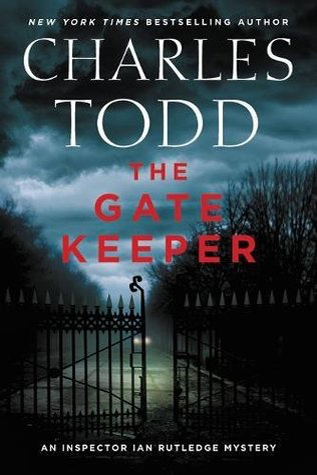I received this book for free from the library in exchange for an honest review. This does not affect my opinion of the book or the content of my review.
Source: the library
Racing the Devil
by
Charles Todd
It is part of the Inspector Ian Rutledge #19 series and is a historical mystery in Hardcover edition that was published by William Morrow on February 14, 2017 and has 352 pages.
Explore it on Goodreads or Amazon
Other books in this series include [books_series]
Other books by this author which I have reviewed include An Impartial Witness, A Lonely Death, A Bitter Truth, The Confession, An Unmarked Grave, The Walnut Tree, Proof of Guilt, A Question of Honor, An Unwilling Accomplice, Hunting Shadows, A Pattern of Lies, A Fine Summer's Day, No Shred of Evidence, The Shattered Tree, A Casualty of War, The Gate Keeper, A Forgotten Place, The Black Ascot, The Cliff's Edge, An Irish Hostage
Nineteenth in the Inspector Ian Rutledge historical mystery series and revolving around events from World War I and a roving Scotland Yard inspector. Events take place on the frontline in France in 1916, along the road from Paris to Nice in 1919, and in 1920 in East Sussex.
My Take
And, yep, the callous behavior of the British command comes through right at the beginning with the description of the German trenches, as does governments who ignore the plight of the men who come back from war.
Government blindness is not the primary theme of the story — man’s greed and using others without thought is — but the horrible aftereffects of war is one of the issues that brings life to the story. There are plenty of minor conflicts to add yet more life: Standish’s psychological issues and his refusal to cooperate is too typically bullheaded and stupid; the family constraints between father and daughter when it comes to love; the wandering husband; the gullible women who think nothing of blackmail; the prideful, poor and otherwise; and, the ranging aid of the police inspectors and constables.
It’s one of the things I adore about mysteries: how the detective manages to find the guilty party with so few clues! Luckily, it’s third-person point-of-view from Rutledge’s perspective, so we know everything he does. Even if there are a few obscure scenes that weren’t cleared up until later in the story — Standish’s hand was one.
One scene that is NOT obscure is the one with Barnes, lol. Rutledge does NOT like him. I love it! It’s a nice bit of support for Mrs. Saunders, who colludes with Rutledge.
It doesn’t take long before the killer begins to target Rutledge, but it isn’t exclusive, as the killer is intent on eliminating anyone who might be able to identify him.
Todd makes it so easy to slip into the time period with the show of how people behaved from manners to expectations to the use of dress to communicate class and career; the conflict between horse and automobile; the deficiencies of communication; and, the efforts involved in solving crime without all the forensic techniques we have today.
It definitely makes me appreciate cellphones!
The Story
They’d lived through the worst of the war. And survived. Now they’ll fulfill that pledge they made on the eve of the bloody Battle of the Somme: They will celebrate their good fortune by racing motorcars they beg, borrow, or own from Paris to Nice.
What none of them will be brave enough to say is how they were nearly forced off the road. Not even the one man who was.
Then “accidents” begin to happen in England. A heavy rainstorm. A crash into a tree.
Scotland Yard Inspector Ian Rutledge discovers that the truth is elusive — and that the villages on the South Downs, where one accident happened, are adept at keeping secrets, frustrating his search.
Determined to remain in the shadows, this faceless killer is willing to strike again to stop Rutledge from finding him. This time, the victim he chooses is a child, and it will take all of Rutledge’s skill to stop him before an innocent young life is sacrificed.
The Characters
November 1920, England
Inspector Ian Rutledge still battles his own demons from World War I with Corporal Hamish MacLeod, a voice in his head. Fiona is the woman Hamish left behind. Frances is Rutledge’s about-to-be-married sister.
The very bright and efficient Melinda Crawford is an old family friend who appears in the Bess Crawford series as well. And, yes, Bess Crawford has a minor role in this. Shanta is Melinda’s Indian housekeeper. Colonel Richard Crawford is Bess’ “retired” father. Sergeant Major Simon Brandon “retired” with the Colonel. George is a friend, a retired naval officer, living in Nice.
Scotland Yard
Markham, a Yorkshireman of few words, has been appointed new acting superintendent. Sergeant Gibson isn’t a friend, but more of a coworker of my enemy with Rutledge. Chief Constable Cummings had been a mentor to Rutledge early on in his career.
Burling Gap is…
…a small village slowly growing smaller as the chalk cliffs drop off into the sea and is Constable Neville‘s patch. The Sailor’s Friend is a local pub where Fiona is wife to the owner and serves as a waitress. Mrs. Grant is furious that her philandering husband, Timothy Grant, a rag-and-bone man, has taken off with her money. Mrs. Mitchell is a gossipy old biddy with a good heart. Mr. Davidson is a regular visitor to his widowed sister.
Harry Dixon, Gerald, and Tom found the body at the lighthouse. Parson Dolby’s cavern is named for the clergyman, who, two hundred years ago, was determined to prevent so many shipwrecks.
East Dedham is…
…the closest bigger town and is policed by the unimaginative, uncaring Constable Brewster. Nathaniel Wright is the rector for St. Simon’s, his first church. Mrs. Saunders is the Rector’s housekeeper. Mr. Stapleton had subbed for Wright while he was a chaplain in the war. The nasty, snotty Jonathan Barnes is sent by the bishop to take over temporarily.
Captain Roger Standish is the local squire with a handicap. Mrs. Donaldson is his cook. Wilson was the previous estate manager. The tenants on his estate include the Tomlinsons, the Meadowses are reduced to the missus and her child, Jem, and the Fieldings with three teenaged sons.
Emily Stuart is the jilted fiancée. Sewell is her coachman.
Dr. Hanby is the nearest doctor. James is a farmer. Trotter, the blacksmith, came back from the war and converted an old blacksmith shop into a motorcar garage. Dicky Melford finally died, leaving behind his grieving parents. The Misters Edgecombe, older and younger, are the local solicitors. Henderson is their clerk.
Eastbourne
Elizabeth Wilding is the younger daughter, seeing a gentleman on the sly. Ginger is the golden retriever she likes to walk. Her disapproving father is Dr. Wilding. Sally is a maid in the Wilding household. Margaret is the older sister who threw another man over to live in London and for a social upgrade to a barrister, Lawrence Montgomery, who is head of chambers at Montgomery, Applegarth, & Winter.
Patricia Sedley runs a shop called Past Perfect. Constable Plant. Delilah and Betty are barmaids at The Jolly Sailor. The gullible Ivy Brown has fled to her mother’s. “Ralph Mercer“, a.k.a., Sergeant Miller, is suffering from head injuries.
Sevenoaks
Major Holt from Surrey runs into a tree. Inspector Judd is most uncooperative. Dr. Lodge is the local surgeon.
Rye
Lieutenant Cedric Russell had moved home to his mother’s. Captain Newland had been his commanding officer.
Hastings
Mr. Ferris, the bishop’s representative, is identified. Inspector Gage is in charge.
Canterbury
Lady Kathleen Marshall is the widow of Sir Wilfred Marshall, who is engaged to be married to an American, Michael Reston. The Dowager Lady Marshall is/was Wilfred’s mother.
Pevensey
Constable Arnold is in charge.
1919, Paris to Nice
Everett has gangrene. Captain Andrew Brothers of Kent is racing Williams’, his brother-in-law’s, [borrowed] car. Taylor, Standish, Russell, and Holt were the only other officers who raced.
1916, before the Somme, France
Dobson bought it here. The rest who pledged included Brothers, Holt, Standish, Russell, Everett, and Taylor. Randolph Graves had driven in the Grand Prix de Monte Carlo twice and almost won. He bought it at Ypres.
Eleanor Hardy receives some mercy at her trial. Boils is the innkeeper of The Boar where an inquest was held.
The Cover and Title
The cover is a deep, dusky blue of the night, a touring car, its headlights blazing, trundling down a dirt track, overshadowed by the arching bare branches of the massive trees that line the road. The author’s name is in a thin serif font while the title is in a thick sans-serif below with both in white. The series information is tiny at the bottom in yellow.
The title is all about Racing the Devil lest he push you off the road.















